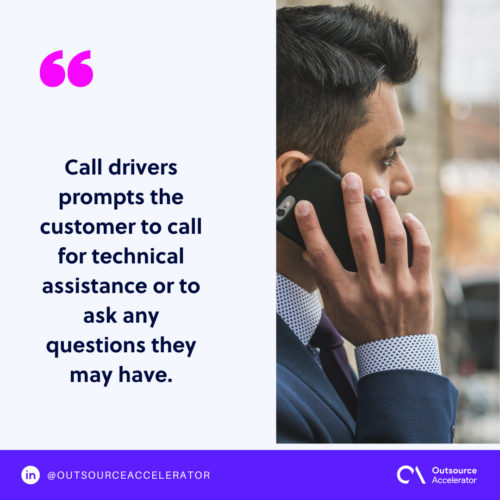Call drivers
Definition
What are the call drivers?
Call drivers are the reasons why customers contact a call center. However, call drivers can also apply through alternative methods such as email, chat, or social media.
It prompts the customer to call for technical assistance or to ask any questions they may have.

Types of call drivers
Understanding the various types of call drivers is essential for businesses to manage and optimize their customer support processes effectively.
Here, we explore the primary categories of the top call drivers:
External factors
Seasonal trends
These are fluctuations in customer inquiries based on seasons, holidays, or special events.
For example, increased call volume during the holiday season for retail businesses.
Marketing campaigns
Peaks in customer interactions can result from the launch of marketing initiatives.
For example, a promotional campaign that generates a surge in product inquiries.
Economic conditions
A notable call driver is the influence of economic factors on customer behavior and support needs.
For example, economic downturns can lead to an increase in billing-related inquiries to center agents for financial services.
Internal factors
Product launches/updates
There might be an increase in customer inquiries related to the introduction or modification of products and services.
For example, more customers may be seeking information and technical support about a new software update for a tech product.
Service outages
This is increased call volume resulting from interruptions in service or technical issues.
For example, telecommunication customers reporting network outages to technical support teams and call centers.
Policy changes
There may be heavy traffic on calls due to customer confusion or concerns arising from alterations to company policies.
For example, calls from insurance policyholders seeking clarification after policy terms are updated.
Understanding the distinction between external and internal factors helps businesses tailor their response strategies to each type of driver.
Impact of call drivers on customer experience
The efficiency with which call drivers are managed significantly influences the overall customer journey and experience.
In this section, we delve into the impact of call drivers on key aspects of customer satisfaction, resolution time, and customer retention.
Customer satisfaction
Customer or caller satisfaction is the bedrock of a successful business, and call drivers play a pivotal role in shaping this perception. The manner in which an agent handles inquiries directly influences how satisfied customers feel after their interaction with customer support.
When call drivers are managed effectively, customers experience:
- Timely responses – Swift and accurate responses to customer inquiries contribute to a positive experience. Customers appreciate efficient resolutions that demonstrate a commitment to their needs.
- Clear communication – Transparent communication regarding issues, solutions, and expectations fosters trust. A well-informed customer is more likely to be satisfied, even if the resolution involves a complex process.
- Personalized service – Tailoring responses to the specific needs of the customer enhances satisfaction. Recognizing individual circumstances and providing personalized solutions show a commitment to customer care.
On the contrary, ineffective management of call drivers can lead to frustration, dissatisfaction, and even negative word-of-mouth.
Customers who feel their concerns are not adequately addressed may develop a diminished perception of the brand, impacting long-term loyalty.
Resolution time
The time it takes to resolve customer inquiries is a critical factor in determining the overall customer experience.
Efficient resolution contributes to customer satisfaction and reflects positively on the company’s commitment to addressing customer needs promptly.
Effective call driver management results in:
- Timely solutions – Rapid identification and resolution of issues demonstrate a proactive approach to customer service. Customers appreciate a swift resolution without unnecessary delays.
- Reduced customer effort – Streamlining processes and minimizing the effort required from customers to resolve their concerns enhances the overall experience. Simplifying complex procedures can significantly impact resolution time.
- First-Contact Resolutions – Resolving issues during the initial customer contact minimizes the need for follow-up interactions. This not only saves time for both the customer and the support team but also contributes to a positive customer perception.
Conversely, prolonged resolution times can lead to dissatisfaction and may even result in customer attrition.
Customers value their time, and extended resolution processes may erode trust and confidence in the company’s ability to meet their needs promptly.
Customer retention
Customer retention is closely tied to the overall customer experience, and call drivers play a pivotal role in influencing whether customers choose to stay with a company or explore alternatives.
Effective call driver management contributes to customer retention by:
- Building trust – Consistently addressing customer concerns and providing satisfactory resolutions builds trust. Trust is a key factor in retaining customers and fostering long-term relationships.
- Demonstrating value – Customers are more likely to stay with a company that demonstrates its commitment to providing value. Effective handling of call drivers showcases a commitment to customer satisfaction and loyalty.
- Minimizing customer churn – Resolving issues promptly and efficiently reduces the likelihood of customers seeking alternatives. Satisfied customers are less inclined to explore competitors’ offerings.
In contrast, poor call driver management may lead to customer dissatisfaction, increasing the risk of customer churn.
Customers who perceive a lack of responsiveness or effectiveness in issue resolution may seek alternative providers, impacting the company’s bottom line.







 Independent
Independent




